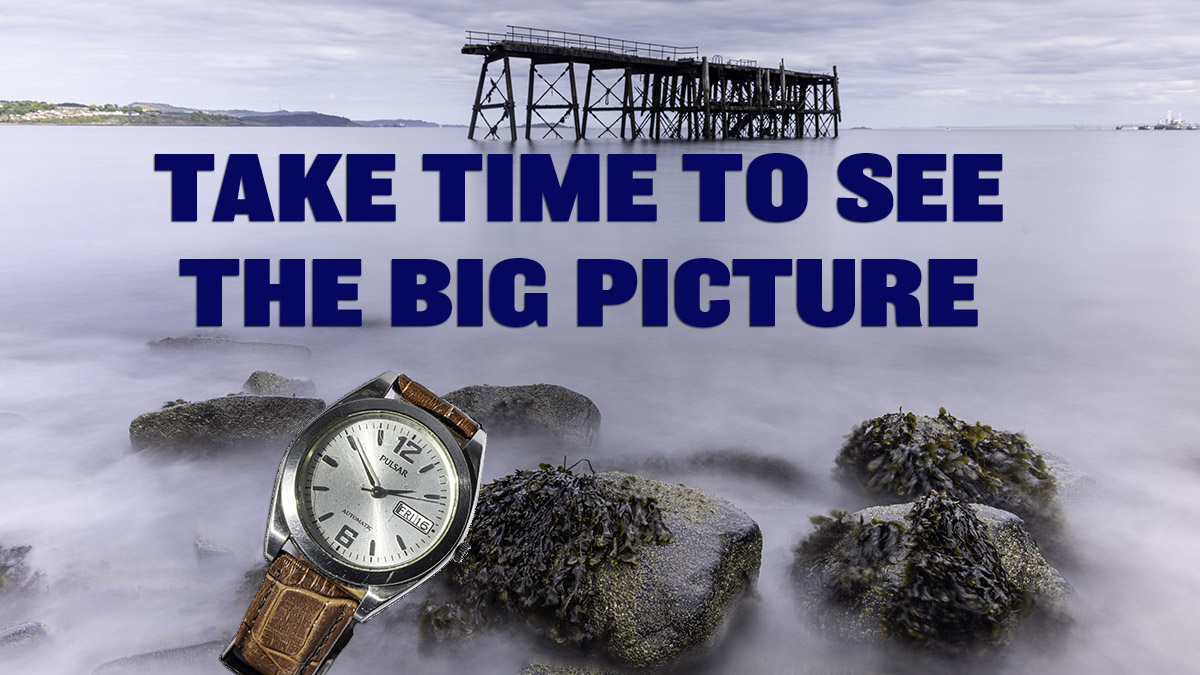August 25, 2022
Take time to see the big picture
Photography isn’t just setting the exposure and pressing a button. Time to see is just as important when taking pictures.

What’s the first thing you do before you take a photograph? I’ll give you some time to think about it before you answer. Scroll down past the clock to see what I believe is the answer.

I imagine a few of you said that you would set the aperture, the shutter speed, or even just switch on the camera. For me, all of those answers are wrong. The first thing that any photographer, regardless of their experience, will do is look at a scene and see something they think will make a picture. I am often told by Switch to Manual attendees that they struggle to capture the scene they saw in a photograph. I’ve used the time off in August to consider why this may be the case.
What is it you see?
I think the issue some people may have is that they aren’t sure what they see. It seems a strange statement, but think about how you see a scene. Often the leap from seeing a scene to pressing the button is too quick. By taking the time to consider what attracted us to the scene, we are more likely to find the photograph that captures our vision.
Our eyes are amazing things. They collect light far better than our cameras ever do and have a wider angle than pretty much any lens on the market. However, that can be a curse as we are given far more information than our brains can cope with. Before you start thinking about buttons and dials, spend some time looking at the scene and breakdown the elements of the vista that attracted you. Once you have it clear in your mind what you are looking at, you can now think about the best way to photograph it. But don’t start thinking about touching those buttons or dials yet. Just because you saw a scene where you are standing doesn’t mean that it’s the best place to take the photograph from. Move around to check if there are better places to include the key components of the scene.
I often work on three simple steps.
- Identify the subject (or subjects) of the scene. The fewer subjects, the better.
- Decide if there is something that can add context to the subject. Often this will be compositional techniques such as leading lines or frames.
- Think about the best settings to join these together.
Try adding this to your workflow and see if you start to get better photographs.
What’s going to happen?
Another aspect I consider before putting the camera to my eye is what is going to happen. I don’t have any mythical foresight. However, if you spend the time watching what is going on, you can make logical and accurate conclusions about what may happen. Last week’s blog on the Edinburgh Festival is an excellent example of this in action. When I saw the street performer climbing up the ladder, it was easy to predict that they would be doing something when they got to the top. There will likely be some kind of juggling involved, so I could position myself in a way that I could frame the performer between the buildings on either side. By taking the time to think about the scene, I have the time to make sure my camera settings will capture it.

We can use the same technique in nature too. One of my favourite locations in the Landscape & Seascape workshop is a ruined submarine pier on the banks of the River Forth. Before I think about the photograph, I know the subject is the structure. I can either just photograph the scene or include elements that provide context, such as the rocks in the foreground. If I choose to include the rocks, it’s still not time to shoot. I’ll check to see if the tide is coming in or out so I can start planning for what the water will do around different rock shapes. Next, I’ll wander along the shoreline to find interesting shapes that will accentuate the movement of the water. Only now will I start to think about the camera settings. It’s the time spent considering the shot that makes it work, not the settings I used on my camera.

What just happened?
The final step I take is to review what I have just photographed. Check around the scene to see if there is an even better way of capturing it. Put the camera down and re-consider what it is that attracted you to the scene. Critically assess the photograph you have just taken to decide if it represents your original vision. If not, think about why not. Are there things in the scene that aren’t needed, and if so, how can you remove them? Taking the time to review the photograph just after you have taken it may save much more time in going back after you have reviewed the picture back at home.
Please give us your feedback.
I’d be really interested to see if you spend time in different ways to capture a by leaving your comments below. You can sign up for the Edinburgh Photography Workshop monthly newsletter, where you’ll get regular updates on exciting things happening in photography and some great tips. Sign up by clicking here.
About the author
As well as running Edinburgh Photography Workshop, Rich Dyson is a professional photographer. His photographs are regularly used in newspapers such as The Times, Guardian and Daily Telegraph. He also had two solo exhibitions and was featured in a members-sponsored exhibition in the Scottish Parliament. You can see and buy his photography at richdysonphotography.com.